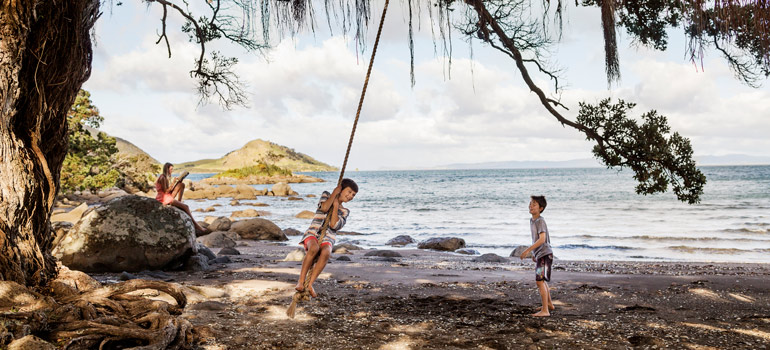Future state 3: Empowering communities
Destination management is owned locally and supported nationally.
On this page

Long-term plans to manage visitor destinations must be developed locally, supported nationally and managed collaboratively. Communities must have the ability to cope with visitor demand, develop the infrastructure needed, and feel connected with their local culture and place.
Future state 3 - Recommendations
To achieve the desired Future State, we recommend:
3.1 Integrated destination management planning – Require destination management plans to be integrated into local planning processes and aligned with a national visitor planning framework
To be developed and implemented effectively, destination management plans need to be co-created by communities and iwi in an integrated manner. This must happen alongside other relevant planning processes and be aligned with a national visitor planning framework. Integrating destination management planning into local, regional and iwi long-term plans is essential because it will enable more efficient use of resources and provide appropriate access to local government funding mechanisms. Aligning destination management with other planning processes – such as DoC’s – is also necessary, and beneficial to ensure coherent and efficient development that aligns with community aspirations. These plans must be well funded and under a constant review cycle to ensure they are delivered and remain relevant.
Mechanisms and incentives for collaboration at scale (for example, public/private and not-for-profit partnerships) should also be developed to encourage investment in co-design and co-governance arrangements that set, manage and respond to destination management priorities. The possible range of public/private partnership initiatives will be broad but should include public infrastructure development and the creation of new visitor industry experiences designed to deliver positive benefits across all 4 wellbeings.
There are many locations of particularly special interest in our visitor economy. Milford Sound (Pipiotahi) is a good example. We need a specific approach to manage the unique situations of places like Milford Sound. To achieve this, we must think and plan at a national level to reorganise how we manage these special places to achieve benefits across all 4 wellbeings. Given the systemic approach, many of the recommendations in this report could be trialled in these kinds of remote locations.
More defined recommendations will be provided in our final report.
3.2 Appropriate destination management structures – Review the organisational structure of local destination management
An independent review is needed to fully understand how best to organise the local and central government structures that currently provide tourism support, economic development and destination management/marketing services.
The scope and principles of this review should include:
- Reviewing how the industry bodies currently perform and, in particular, how they can interact with and guide government most effectively.
- Reviewing all local and regional council tourism entities. This review should determine the best ways for these entities to:
- Align activities with the visitor industry vision.
- Enhance Mauri within and beyond their own territorial boundaries.
- Create scale efficiencies and leverage assets beyond their own boundaries.
- Drive decision-making from a local community level.
- Align with destination management plans.
- Monitor and understand the journeys that customers take across the country, rather than just within their district.
- Monitor and understand the different interest segments that travel to and through their district.
3.3 Enriching Aotearoa New Zealand – Establish a contestable fund dedicated to achieving the 4 wellbeings
Incentives will encourage the industry to develop new products and experiences that leverage existing assets, such as Marae, Christchurch red-zone areas or community gardens (illustrative examples only); build new national visitor assets, like the Great Walks or cycleways; or connect with other sectors like regenerative agriculture, food production, healthcare, wellness, education and conservation. These new products can be leveraged from the destination management planning framework.
This initiative could include using a matched funding approach, and criteria should specifically ensure that the new visitor products and experiences are:
- Accessible and affordable to New Zealanders.
- Attractive to international visitors as a way to enjoy nature, participate in Aotearoa New Zealand's culture, and experience wellness.
- Making appropriate use of new technologies.
- Aligned with local destination management strategies and plans (for example, by reducing peak-season concentration or increasing low-season demand).
- Consistent with an intention to deliver net benefits across all 4 wellbeings.

Future state 3 - System funding
The visitor economy raises complex questions about who pays for what and when. Visitors interact with most aspects of Aotearoa New Zealand’s society, infrastructure and economy in one way or another. While this means that visitors contribute financially in some shape or form, there is a shortage of agreed data points and philosophies. This needs to be addressed.
What we do know is that, within the visitor economy system, there is a lack of connectivity between the costs of visitors using infrastructure and local services, on the one hand; and the tax revenues received from the visitor economy, on the other. In the absence of any good data, this absence of connection leads to a point of conflict about whether visitors are paying their way or not. This issue needs to be properly understood and clarified to ensure costs are not disproportionately allocated.
Despite this, there is a universally accepted view that there is an infrastructure shortfall in Aotearoa New Zealand. There are areas across the country where the intensity of tourism is absolutely disproportional to the rating base of local councils.
Future state 3 - Recommendations
To achieve the desired Future State, we recommend:
3.4 Funding – Undertake an independent study about how to develop a sustainable and equitable funding mechanism based on a robust understanding of the costs and benefits of visitors
We need to properly understand the baseline position for how the costs and benefits of visitor activities are derived. We recommend undertaking an independent study to establish this baseline as the foundation for developing a sustainable and equitable funding mechanism.
We also recommend that there should be a mandated hypothecation back to the visitor industry of any new sources of revenue and/or taxes that are derived directly from visitors. The investment of those funds should be based on the following principles:
- Mechanisms are adaptable to adjust revenue to demand, both seasonally and cyclically over time.
- Differential rates for domestic and international visitors are appropriate.
- Revenue is generated as close as possible to the point of use.
- Local government funding is linked to tourism flows and use.
- Implementation follows the transition principles described within this report.
- Technology is funded and used to create effective and efficient collection methods; for example, digital payment capability at the point of use.
- Existing effective technology should be leveraged over creation of new technology.
- Funding should be used to directly incentivise the development of the Mauri of an area.
- Funding should align with destination management plans that take into account the 4 wellbeings approach.
The Taskforce intends to address this issue further in the period between the release of our interim and final reports.
3.5 Funding – Continue allocating funding to the visitor industry from the existing consolidated Fund (the government's central funding pool)
Funding should be allocated to the visitor industry from the Consolidated Fund in accordance with the following principles:
- Tourism New Zealand should be funded to generate domestic and international demand development in line with the competitive global landscape and in line with Aotearoa New Zealand’s visitor industry vision.
- Where market failure occurs, the government should fund (or seed fund) projects as well as hard and soft infrastructure, but only if an appropriate capital return from that funding is demonstrated.
This dedicated funding should be formally committed to and set within the proposed new Ngā Manuhiri o Aotearoa (New Zealand Visitors) legislation. This will ensure a systemic long-term approach in a similar manner to the way the Brand USA/ESTA legislation works.


